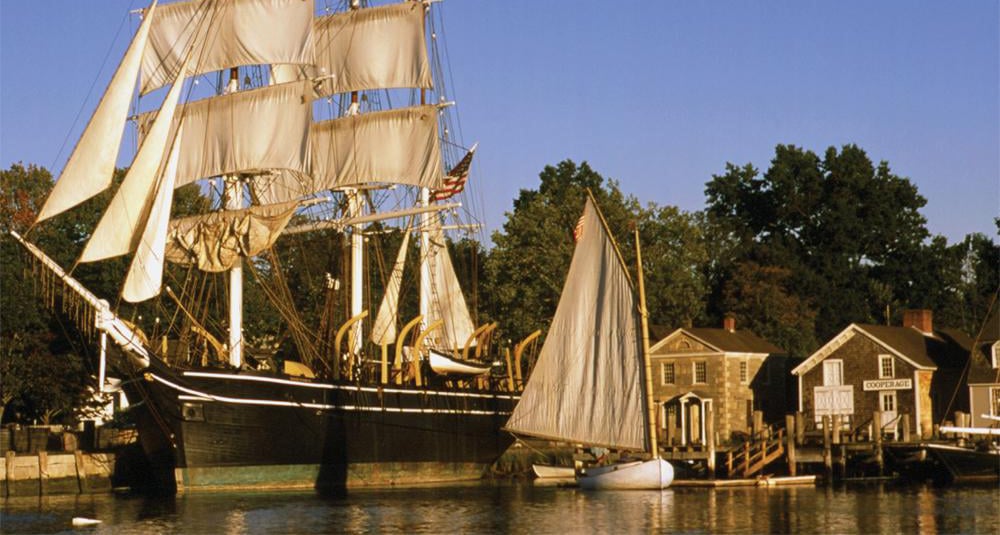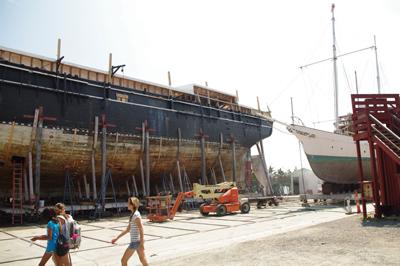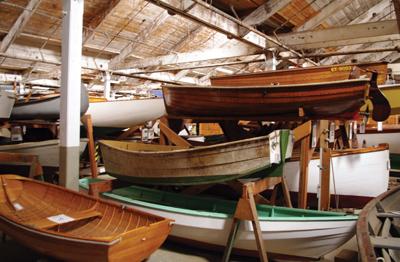
Mystic Seaport Museum
Imagine 17 acres along the Mystic River, a stone’s throw from the beautiful eastern Connecticut shoreline. Stroll through a seafaring town of the late 1800s, where the shipsmith will teach you how to forge a harpoon over a coal fire. At the cooperage, watch barrel staves being bent. Help set a sail on the tall ship Joseph Conrad or observe a man overboard drill aboard the L.A. Dunton, a classic 19th-century fishing schooner. Take a ride on Sabino, a coal-fired steamboat, or rent one of the small craft available to visitors at the boathouse. All of this is only the beginning, the tiniest taste, of the feast that awaits you at the Mystic Seaport Museum.
I’ve been to the museum three times in the last year, and each time, I come away more in love with the place. Granted, I am a boat nut, but it’s hard to imagine even a sworn landlubber not swooning after a day exploring MSM’s bounty. The truth is, most people never get past the most obvious of the museum’s delights — and with good reason. Scratching the surface is enough to provide days of entertainment, but dig any deeper and you may find yourself looking at local real estate, scheming, as I recently did, about how you could possibly make exploring the magical Mystic Seaport Museum a routine part of your life.
But of course, life at Mystic is never routine. I want to be there when the 24-hour “Moby Dick” reading happens aboard the Charles W. Morgan, the world’s last remaining wooden whaleship. I would love to spend a few months of rainy days going through the museum’s collections of scrimshaw, Rosenfeld photography, model boats, ship plans and manuscripts. I want to know what they’re working on up at the Williams-Mystic labs — the day I stopped by, they had just found the first of an invasive species of European shrimp in a Massachusetts pond! And, perhaps I want — most of all — to slip quietly into the small-craft collection and simply gaze in wonder at the vast, dusty specimens that range from catboats to iceboats to rowing sculls to Hickman Sea Sleds, which slumber in two huge sheds, silently chronicling the lineage of recreational boating over the last 150 years or so. This treasure trove is Mystic’s attic: These boats are documented and preserved for posterity, but there are too many to exhibit, so they’re relegated to mandatory bed rest. When I toured this collection, I had to resist the warring, unseemly urges to jump up and down with excitement and kneel in awe.

Right now, Mystic is running a series of television ads designed to lure families away from the-shopping-mall-as-family-entertainment. As a couple of kids look on in wideeyed delight while the shipsmith hammers hot metal, a salty voiceover declares, “Flames. Hammers. Sparks. Any father can bring his sons to some plastic playscape. But today you took them to Mystic Seaport, and a time when everything was approximately 1,000 percent more awesome. Today, Dad, you earned your sea legs.”
Stephen C. White, Mystic Seaport Museum’s president and CEO, who stepped into his role less than two years ago at one of the most challenging times in the institution’s history, likes the new ads. White used to be headmaster at the Fay School in Southborough, Massachusetts, so he’s an educator with experience at fundraising. He also grew up sailing aboard his family’s Friendship sloop, and he cares deeply about the mission of Mystic Seaport Museum.
“Right now, museums like this place need attention. America has forgotten the relevance of these institutions,” White told me as we lunched on the patio at Schaefer’s Spouter Tavern on the Mystic Seaport grounds. “We’re in danger of forgetting the relevance of history.” Loving sailing’s traditions, White remarks, should not be just about flaunting your Nantucket reds.
“These days,” he went on, “Mystic is doing what everybody else is — whatever they can to get by.” White says that about 50 percent of the Seaport Museum’s income is derived from gifts, grants and membership bequests. The other 50 percent comes from contributed income: gate, programs, events, etc. But the goal is to increase visitor attendance by 10 percent.
No exhibit at Mystic Seaport is more popular, or better reinforces White’s point on the relevance of seafaring tradition, than the whaleship Charles W. Morgan. An estimated 20 million people have walked the decks of this National Historic Landmark since she arrived at the museum in 1941, at the age of 100, and just weeks before Pearl Harbor was attacked. Today, she is undergoing a fouryear, $10 million restoration. When she’s finished, she will be as seaworthy as she ever was, and the museum plans to sail her again. In the meantime, visitors can still go aboard this historic marvel and get a sense of what life aboard a whaleship was like. Visit the captain’s quarters in the stern, which seem surprisingly spartan despite a velvet-upholstered settee — that is, until you visit the cramped fo’c’sle, less than 100 feet forward, which held more than 30 men in narrow wooden berths. An atmospheric audio loop narrates their experiences, giving you a real sense of what it must have been like to live cheek-to-jowl, slamming through high seas to the ever-present odor of less-than-fresh shipmates and rendered whale blubber.
Meanwhile, directly beneath your feet, present-day work on the Morgan continues. More than 50 percent of the framing has now been completed here in the Mystic Preservation Shipyard. Massive pieces of live oak felled by Hurricane Katrina will be used in the ship’s restoration, as will a recently discovered trove of timber from the Charleston Naval Shipyard (aka the Boston Naval Shipyard) that’s more than 100 years old.
Matthew Stackpole, the seaport’s major-gifts officer and a noted historian, is passionate about the importance of the Charles W. Morgan to Mystic. “Whaling put America on the map. It powered the Industrial Revolution, providing oil to light lamps and to lubricate machines.” Vast fortunes were made and the cultural landscape of America changed. Stackpole, who grew up playing aboard the Morgan (his father, Eduoard, was the curator of the Mystic Seaport Museum from 1951 to 1966 and an author of multiple classics on whaling) conveys all the boyish excitement of someone who has lived and breathed the history of the sea since he was a toddler. When we walk down the dirt road through the historic seaside village that houses a bank, a chapel, a ropewalk, a cooperage, the shipsmith, a drugstore, a print shop and other businesses, he remarks, “This is not just a pretty piece of history. It’s meant to remind us of the infrastructure and industry that was required to sustain a seafaring town.”

That brings us to Mystic’s greatest asset: its people. Stackpole is an example, as is Quentin Snediker, who oversees Mystic’s Preservation Shipyard, where the Morgan is being restored. Described by someone to me as the “rock star” of the shipbuilding world, Snediker is a master shipwright who supervised the building of the 129-foot Freedom Schooner Amistad, a replica of the ship La Amistad from which 56 Africans escaped while off the coast of Havana. They seized control of the vessel and commanded their captors to return them to Africa. Instead, the crew sailed east by day and west by night, until they were intercepted by a Navy cutter off the coast of Connecticut. The subsequent Supreme Court case over the slaves’ fate resulted in their freedom and was a major victory for abolitionists.
Amistad is now operated by Amistad America, a nonprofit foundation focusing on educating the public about slavery, discrimination and civil rights. This year she will embark on a historic voyage across the Atlantic to Africa and back to the Caribbean. (Yachting will feature an article on this momentous trip in 2011.) Snediker was aboard Amistad when she sailed into Havana this spring to mark the United Nations’ International Day of Remembrance of the Victims of Slavery and the Transatlantic Slave Trade and the ship’s 10th anniversary, and it’s clear that Amistad’s cause is every bit as important to him as the ship he built. Right now, Amistad is back at Mystic and open to visitors while she undergoes repairs before her next historic journey.
Mystic Seaport Museum has an astounding collection of historical objects, for sure. But it is an institution that is powered largely by passionate people — its members, its “interpreters” who wear period dress and interact with visitors at various exhibits, its “demonstration squads,” its huge flotilla of volunteers, its very dedicated and knowledgeable professional staff — and, of course, its visitors and donors.
If you haven’t been to Mystic Seaport Museum, you’re missing out on one of America’s most vital cultural institutions — one that engages visitors in an experience that edifies without ever going anywhere near the outskirts of boring. The Mystic area is a great place for a family vacation — close to beaches, the Mystic Aquarium and the lovely town of Mystic. Do as much or as little as you want, but whatever you do: GO, and become a member so this important link to our nautical history stays vibrant for generations to come.









